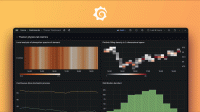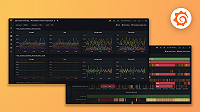Caution
Grafana Alloy is the new name for our distribution of the OTel collector. Grafana Agent has been deprecated and is in Long-Term Support (LTS) through October 31, 2025. Grafana Agent will reach an End-of-Life (EOL) on November 1, 2025. Read more about why we recommend migrating to Grafana Alloy.
loki.source.docker
loki.source.docker reads log entries from Docker containers and forwards them
to other loki.* components. Each component can read from a single Docker
daemon.
Multiple loki.source.docker components can be specified by giving them
different labels.
Usage
loki.source.docker "LABEL" {
host = HOST
targets = TARGET_LIST
forward_to = RECEIVER_LIST
}Arguments
The component starts a new reader for each of the given targets and fans out
log entries to the list of receivers passed in forward_to.
loki.source.docker supports the following arguments:
| Name | Type | Description | Default | Required |
|---|---|---|---|---|
host | string | Address of the Docker daemon. | yes | |
targets | list(map(string)) | List of containers to read logs from. | yes | |
forward_to | list(LogsReceiver) | List of receivers to send log entries to. | yes | |
labels | map(string) | The default set of labels to apply on entries. | "{}" | no |
relabel_rules | RelabelRules | Relabeling rules to apply on log entries. | "{}" | no |
refresh_interval | duration | The refresh interval to use when connecting to the Docker daemon over HTTP(S). | "60s" | no |
Blocks
The following blocks are supported inside the definition of loki.source.docker:
| Hierarchy | Block | Description | Required |
|---|---|---|---|
| client | client | HTTP client settings when connecting to the endpoint. | no |
| client > basic_auth | basic_auth | Configure basic_auth for authenticating to the endpoint. | no |
| client > authorization | authorization | Configure generic authorization to the endpoint. | no |
| client > oauth2 | oauth2 | Configure OAuth2 for authenticating to the endpoint. | no |
| client > oauth2 > tls_config | tls_config | Configure TLS settings for connecting to the endpoint. | no |
| client > tls_config | tls_config | Configure TLS settings for connecting to the endpoint. | no |
The > symbol indicates deeper levels of nesting. For example, client > basic_auth refers to an basic_auth block defined inside a client block.
These blocks are only applicable when connecting to a Docker daemon over HTTP
or HTTPS and has no effect when connecting via a unix:/// socket
client block
The client block configures settings used to connect to HTTP(S) Docker
daemons.
| Name | Type | Description | Default | Required |
|---|---|---|---|---|
bearer_token_file | string | File containing a bearer token to authenticate with. | no | |
bearer_token | secret | Bearer token to authenticate with. | no | |
enable_http2 | bool | Whether HTTP2 is supported for requests. | true | no |
follow_redirects | bool | Whether redirects returned by the server should be followed. | true | no |
proxy_url | string | HTTP proxy to send requests through. | no | |
no_proxy | string | Comma-separated list of IP addresses, CIDR notations, and domain names to exclude from proxying. | no | |
proxy_from_environment | bool | Use the proxy URL indicated by environment variables. | false | no |
proxy_connect_header | map(list(secret)) | Specifies headers to send to proxies during CONNECT requests. | no |
bearer_token, bearer_token_file, basic_auth, authorization, and oauth2 are mutually exclusive, and only one can be provided inside of a http_client_config block.
no_proxy can contain IPs, CIDR notations, and domain names. IP and domain
names can contain port numbers. proxy_url must be configured if no_proxy
is configured.
proxy_from_environment uses the environment variables HTTP_PROXY, HTTPS_PROXY
and NO_PROXY (or the lowercase versions thereof). Requests use the proxy from
the environment variable matching their scheme, unless excluded by NO_PROXY.
proxy_url and no_proxy must not be configured if proxy_from_environment
is configured.
proxy_connect_header should only be configured if proxy_url or proxy_from_environment are configured.
basic_auth block
The basic_auth block configures basic authentication for HTTP(S) Docker
daemons.
| Name | Type | Description | Default | Required |
|---|---|---|---|---|
password_file | string | File containing the basic auth password. | no | |
password | secret | Basic auth password. | no | |
username | string | Basic auth username. | no |
password and password_file are mutually exclusive, and only one can be provided inside a basic_auth block.
authorization block
The authorization block configures custom authorization to use for the Docker
daemon.
| Name | Type | Description | Default | Required |
|---|---|---|---|---|
credentials_file | string | File containing the secret value. | no | |
credentials | secret | Secret value. | no | |
type | string | Authorization type, for example, “Bearer”. | no |
credential and credentials_file are mutually exclusive, and only one can be provided inside an authorization block.
oauth2 block
The oauth2 block configures OAuth2 authorization to use for the Docker
daemon.
| Name | Type | Description | Default | Required |
|---|---|---|---|---|
client_id | string | OAuth2 client ID. | no | |
client_secret_file | string | File containing the OAuth2 client secret. | no | |
client_secret | secret | OAuth2 client secret. | no | |
endpoint_params | map(string) | Optional parameters to append to the token URL. | no | |
proxy_url | string | HTTP proxy to send requests through. | no | |
no_proxy | string | Comma-separated list of IP addresses, CIDR notations, and domain names to exclude from proxying. | no | |
proxy_from_environment | bool | Use the proxy URL indicated by environment variables. | false | no |
proxy_connect_header | map(list(secret)) | Specifies headers to send to proxies during CONNECT requests. | no | |
scopes | list(string) | List of scopes to authenticate with. | no | |
token_url | string | URL to fetch the token from. | no |
client_secret and client_secret_file are mutually exclusive, and only one can be provided inside an oauth2 block.
The oauth2 block may also contain a separate tls_config sub-block.
no_proxy can contain IPs, CIDR notations, and domain names. IP and domain
names can contain port numbers. proxy_url must be configured if no_proxy
is configured.
proxy_from_environment uses the environment variables HTTP_PROXY, HTTPS_PROXY
and NO_PROXY (or the lowercase versions thereof). Requests use the proxy from
the environment variable matching their scheme, unless excluded by NO_PROXY.
proxy_url and no_proxy must not be configured if proxy_from_environment
is configured.
proxy_connect_header should only be configured if proxy_url or proxy_from_environment are configured.
tls_config block
The tls_config block configures TLS settings for connecting to HTTPS Docker
daemons.
| Name | Type | Description | Default | Required |
|---|---|---|---|---|
ca_pem | string | CA PEM-encoded text to validate the server with. | no | |
ca_file | string | CA certificate to validate the server with. | no | |
cert_pem | string | Certificate PEM-encoded text for client authentication. | no | |
cert_file | string | Certificate file for client authentication. | no | |
insecure_skip_verify | bool | Disables validation of the server certificate. | no | |
key_file | string | Key file for client authentication. | no | |
key_pem | secret | Key PEM-encoded text for client authentication. | no | |
min_version | string | Minimum acceptable TLS version. | no | |
server_name | string | ServerName extension to indicate the name of the server. | no |
The following pairs of arguments are mutually exclusive and can’t both be set simultaneously:
ca_pemandca_filecert_pemandcert_filekey_pemandkey_file
When configuring client authentication, both the client certificate (using
cert_pem or cert_file) and the client key (using key_pem or key_file)
must be provided.
When min_version is not provided, the minimum acceptable TLS version is
inherited from Go’s default minimum version, TLS 1.2. If min_version is
provided, it must be set to one of the following strings:
"TLS10"(TLS 1.0)"TLS11"(TLS 1.1)"TLS12"(TLS 1.2)"TLS13"(TLS 1.3)
Exported fields
loki.source.docker does not export any fields.
Component health
loki.source.docker is only reported as unhealthy if given an invalid
configuration.
Debug information
loki.source.docker exposes some debug information per target:
- Whether the target is ready to tail entries.
- The labels associated with the target.
- The most recent time a log line was read.
Debug metrics
loki_source_docker_target_entries_total(gauge): Total number of successful entries sent to the Docker target.loki_source_docker_target_parsing_errors_total(gauge): Total number of parsing errors while receiving Docker messages.
Component behavior
The component uses its data path, a directory named after the domain’s
fully qualified name, to store its positions file. The positions file is used
to store read offsets, so that if a component or Grafana Agent restarts,
loki.source.docker can pick up tailing from the same spot.
If the target’s argument contains multiple entries with the same container
ID (for example as a result of discovery.docker picking up multiple exposed
ports or networks), loki.source.docker will deduplicate them, and only keep
the first of each container ID instances, based on the
__meta_docker_container_id label. As such, the Docker daemon is queried
for each container ID only once, and only one target will be available in the
component’s debug info.
Example
This example collects log entries from the files specified in the targets
argument and forwards them to a loki.write component to be written to Loki.
discovery.docker "linux" {
host = "unix:///var/run/docker.sock"
}
loki.source.docker "default" {
host = "unix:///var/run/docker.sock"
targets = discovery.docker.linux.targets
forward_to = [loki.write.local.receiver]
}
loki.write "local" {
endpoint {
url = "loki:3100/api/v1/push"
}
}Compatible components
loki.source.docker can accept arguments from the following components:
- Components that export Targets
- Components that export Loki
LogsReceiver
Note
Connecting some components may not be sensible or components may require further configuration to make the connection work correctly. Refer to the linked documentation for more details.



